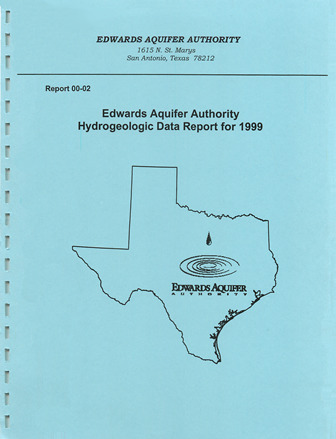Edwards Aquifer Authority Hydrogeologic Data Report for 1999

| Author | Esquilin R, Lillibridge BC, Mahula DM, Mireles J, Hoyt JR and Schindel G |
| Year | 2000 |
| Description | Annual report for 1999 on recharge, discharge, water levels and water quality in the Edwards Aquifer San Antonio Region. Note: Large‐format versions of the plates for this report are available at: https://www.edwardsaquifer.org/documents/2000_Esquil in‐etal_1999HydrologicData‐Plates.pdf. |
| Report Number | 00-02 |
| Publisher | Edwards Aquifer Authority |
| Location | Edwards Aquifer - San Antonio Area |
| Cover | View Download |
| File | View Download |
| Summary |
|
In 1999, discharge from the Edwards Aquifer was greater than recharge as demonstrated by periods of decreasing water levels. The net decrease in water levels in the Bexar County index well was 22.6 feet for the year. The amount of rain received in the San Antonio region in 1999 was approximately 45% below normal. The average estimated annual groundwater recharge to the Edwards Aquifer in the San Antonio region from 1934 through 1999 is approximately 680,000 acre-feet. Recharge in 1999 was approximately 473,400 acre-feet. The lowest annual recharge of 43,700 acre-feet occurred in 1956, and the highest annual recharge of 2,486,000 acre-feet occurred in 1992. Estimated annual discharge from the Edwards Aquifer through wells and springs in 1999 was 898,800 acre-feet. The lowest annual discharge through wells and springs was 388,800 acre-feet, which occurred in 1955. Spring discharge from the Edwards Aquifer for 1999 was calculated at 456,100 acre-feet or 51 percent of the total discharge. Groundwater pumping accounted for 442,700 acre-feet of water discharged from the Edwards Aquifer in 1999. In general, water level data during 1999 reflected a decrease in water recharging the aquifer, although there was a decrease in pumping relative to 1998. In 1999, the Authority collected water quality samples from 57 wells, two springs and eight stream basins. The water samples were analyzed for major ions, minor element metals, TDS, hardness and nutrients. Water samples from 12 wells, two springs and eight surface water locations were also analyzed for pesticides and herbicides. Water samples from eight wells and one spring were also analyzed for VOCs. None of the constituents analyzed were detected above published MCLs. No pesticides, herbicides, or VOC’s were detected in the water samples analyzed for these compounds. |
Search for Documents
Advance Search
Explore EAA's Scientific Reports
- All Reports
- Groundwater Recharge, Recharge Zone
- Groundwater Movement
- Geomorphology and Caves
- Weather Modification
- Geology
- Water Use and Conservation
- Geochemistry
- Water Resources Planning and Management
- Floods and Drought
- Water Quality
- Climatology
- Surface Water / Groundwater Relationship
- Biology
- Springs, Groundwater Discharge
- Archaeology
- RZ Protection
- Aquifer Levels
- Remote Sensing
- Precipitation
- Overview Studies
- Modeling
- Hydrology and Hydrogeology
- History
